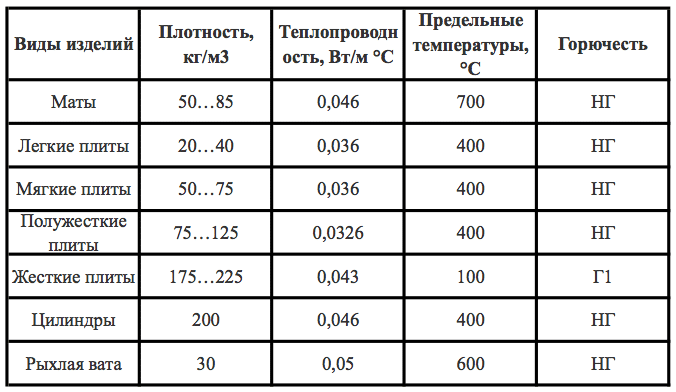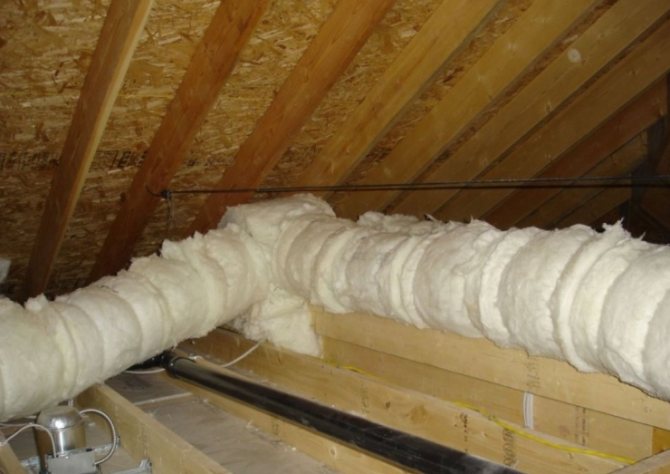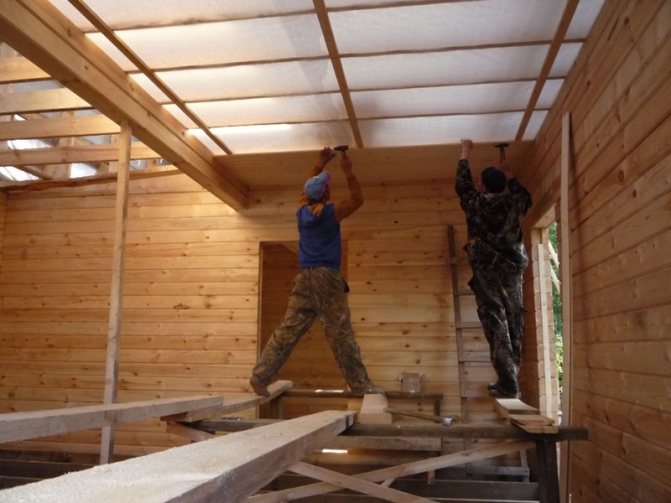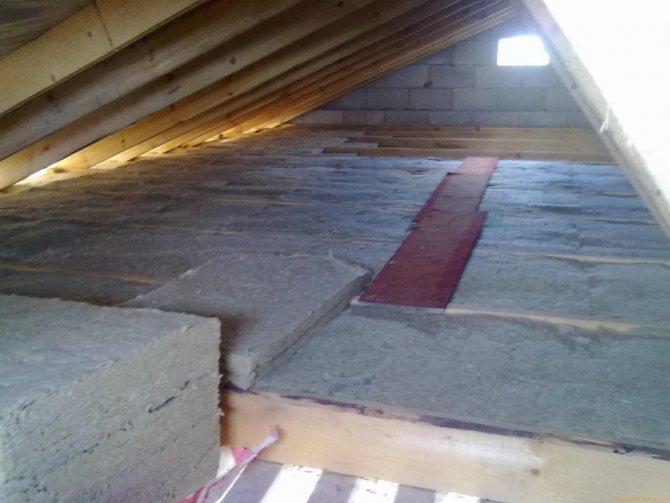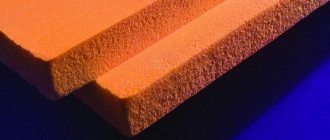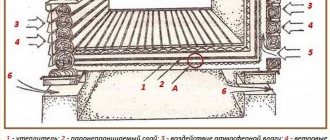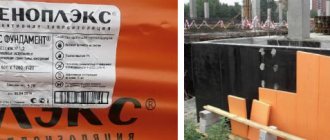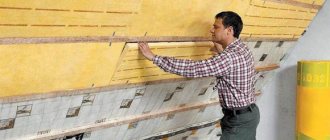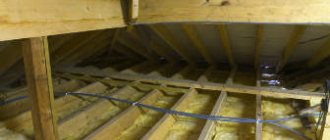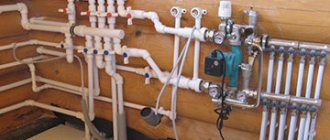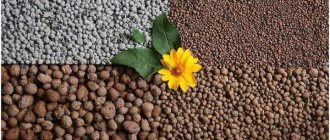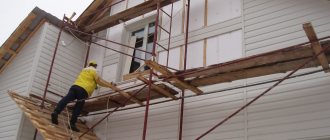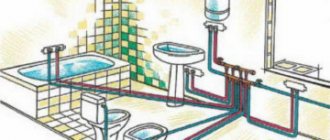Keeping your home warm is one of the top priorities for a comfortable and healthy life. A system of “warm floors” is used to retain heat from below, and various plastic structures are used to prevent heat from escaping through walls and windows. But it is especially important to eliminate heat loss through the ceiling. And because about thirty percent of the heat goes through the top of the room (due to the convection effect), and because the lack of thermal insulation leads to the formation of condensation on it (due to the temperature difference on both sides of the ceiling) and an increase in humidity in the room, which means to the appearance of fungus and mold.
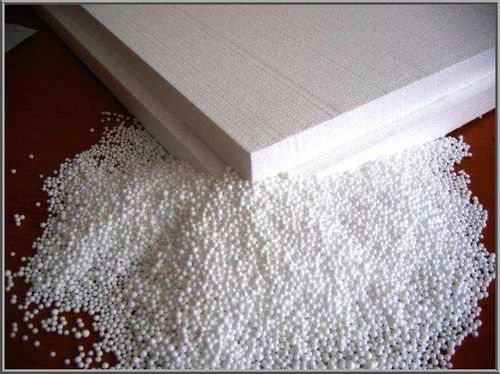
Polyfoam has zero vapor permeability. In addition, this material is easy to install and a fairly budget option for effective insulation.
Fastening of insulation to the ceiling can be carried out both from above (from the attic side) and from below (in the room).
If for some reason it is impossible to insulate the ceiling from above, then for insulation from below the best option is to use the following non-bulk (expanded clay, sawdust) materials:
- polystyrene (expanded polystyrene). It is produced in the form of squares measuring 1 × 1 m, with a thickness of 2 to 10 cm. It is non-hygroscopic (does not damp), which means that the thermal insulation does not change with fluctuations in the level of humidity. It is easy to fix with glue to the rough base of the ceiling, therefore it is also used as an intermediate insulation for suspended frames;
- mineral wool (glass wool, basalt wool, ecowool and other varieties). Supplied in rolls (carpet) and bales (blocks). In the roll type, one side of the mineral wool can be covered with foil, which increases the effect of thermal insulation. Fastening to the ceiling is carried out using a wooden or metal frame made of profiles. Cheaper than polystyrene with the same good thermal insulation. More environmentally friendly, as mineral fibers do not emit harmful substances. Possesses high fire safety and retains all its properties at temperature extremes. It is not subject to decay and is not a breeding ground for insects;
- foamed polyethylene foam - foamed polyethylene glued to aluminum foil. Available in rolls 100 cm wide and 1 to 20 mm thick. Often, thin insulation is used in combination with mineral wool to increase the power of the thermal barrier and protect against carcinogens that can come from certain types of wool. It is convenient to fix it with glue and construction fungi-dowels;
- polyplex. It is obtained from expanded polystyrene by extrusion (forcing through special forms of polymer melt). It is produced in sheets with a size of 60 × 120 cm with a thickness of 1 to 20 cm. It has a high density, and therefore is often used both as insulation and as a rough base for ceiling putty. Can be fixed with dowel mushrooms or U-shaped holders.
Insulation from below: how to fix
To create a frame from transversely and longitudinally located profiles, cells are made, attaching them to the ceiling with nails, dowels or screws.
For any insulation, either special fasteners or a suspended frame will be needed. The easiest way is to fill the space between the suspended and main ceilings with a thermal insulator. In this way, it is convenient to fix the insulation in high rooms.For rooms with a small space, it is more convenient to use penoplex or polystyrene, the sheets of which are glued to the ceiling with ordinary tile glue, and then fastening with special construction fungi-dowels is performed for greater strength.
Considering the popularity of such insulation as mineral wool, in view of its durability, environmental friendliness, fire resistance and low prices, let us dwell on its ceiling installation in more detail.
Stages of work
Ceiling insulation scheme with mineral wool.
We use mineral wool in the form of slabs, wooden beams (metal frame can be used) and drywall sheets.
- A layer of waterproofing, any insulating material (film, glass beads, etc.), is attached with a stapler to the rough base of the ceiling. Cloths of the film with a stele overlap a few centimeters.
- The assembly of the frame, wood or metal, is fixed with a puncher and dowels.
- Laying of mineral wool: we glue the wool slabs to the ceiling using tile adhesive (provides quick adhesion of the ceiling and wool surface).
- On top of the insulation, we again lay the waterproofing material.
- We mount plasterboard ceiling sheathing using self-tapping screws.
Tools and materials other than cotton wool:
- knife, hacksaw, hammer;
- self-tapping screws, screws;
- grinder, electric drill, screwdriver;
- construction stapler (fix the film to the ceiling);
- waterproofing film, wooden beams or metal profiles, drywall, polyurethane foam.
For any owner who knows how to hold tools in his hands, insulating the ceiling in his house on his own is quite a feasible job. And realize your tastes, and save the budget!
Inhabitants of private houses are often very cold in winter. Indeed, through windows and doorways, cracks in the floor, as well as walls, heat goes outside. To solve this problem, mineral wool helps well for insulating the ceiling.
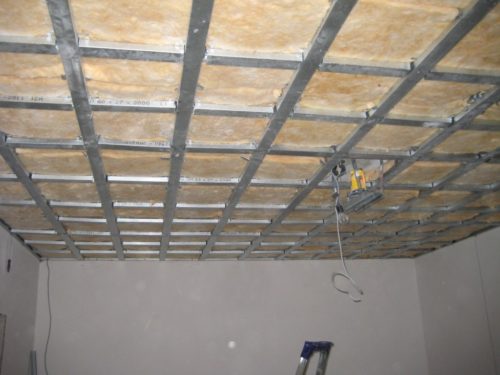

Below in the article, a video of the ceiling insulation with mineral wool with your own hands is published, as well as the main nuances of installing this building material.
Insulation of the ceiling with mineral wool
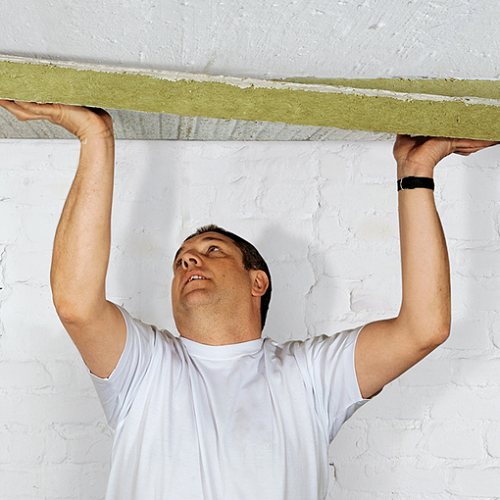

Mineral wool is a widely used fibrous thermal insulation material. It is made from waste of the metallurgical industry, glass, as well as from volcanic rocks. Manufacturers produce mineral wool in the form of mats or rolls. This material has a very low thermal conductivity, resistance to high temperatures, excellent sound insulation characteristics, and is relatively inexpensive.
But there are some disadvantages when using this material:
- Poor moisture resistance.
- Wet mineral wool is not resistant to mechanical damage.
- May cause an allergic reaction when working. Protection of exposed areas of the body is required.
What is the best mineral wool for the ceiling
When choosing, pay attention to the thickness of mineral wool for ceiling insulation. For soundproofing the ceiling in the apartment, fire-resistant mineral wool 5 cm thick is nailed to the top.
The ceilings of a cottage or a private house are covered with at least 15 cm thick mineral wool. An important indicator is the density of the mineral wool. The higher it is, the greater the load the building material can withstand. Such a density is considered optimal - 80 kg / cu. m.
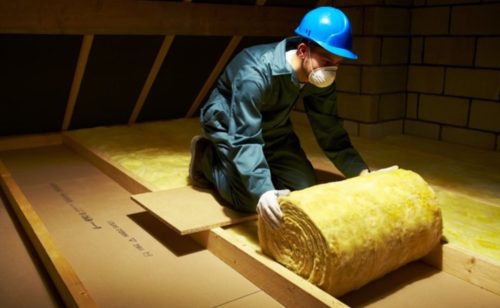

On sale there is mineral wool in tiles and in rolls. Slabs are bought for internal insulation, because they are made according to standard sizes and it is more convenient to cover the surface of the ceiling with them. When insulating from the side of the attic, use mineral roll wool.
Mineral foil wool is also sold on the construction market. It is more expensive than usual. However, when attaching mineral wool to the ceiling, they do not additionally buy a waterproofing building material - foil-clad polyethylene foam or a dense polyethylene film.
Sheathing of ceilings with mineral wool is carried out in the attic or indoors. More on this below in the article.
Options and features of insulation
Having dealt with the types of insulation materials, you should figure out how to fix the insulation. Insulation can be conditionally divided into two options. Both are fairly applicable and depend on needs and capabilities. Execution of work is subject to the hands of any person and significantly saves you money.
Option - on top
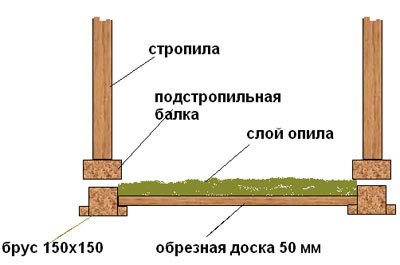

Scheme of insulation with sawdust of a wooden covering.
In this case, we mean the upper side of the ceiling, in simple words - the attic. Use any material that fits and does not require special fixing. It is important to cover everything without leaving any gaps. The work is subdivided into:
- ceilings are made in the form of beams;
- the thermal insulation material is correctly placed and laid;
- facing work is in progress; if it is a private house, the attic is “sewn up” with a board for ease of movement around it.
In this case, and any other insulation, you need to remember about moisture insulation. It is important. Therefore, do not hesitate to consult your dealer for which side of the material is laid down.
Insulation of the ceiling from above makes it possible to do everything with maximum tightness and quality.
Option - bottom
This option is considered as insulation of the inner part of the ceiling and is used for a completed structure that requires insulation. Here you will definitely not need bulk insulation mixtures. You should pay attention to rolled insulation and in mats. This option is rather inconvenient to implement, compared to the previous one. This is due to the fact that the insulation is installed and pressed from below. Inconvenience in material placement and quality control. Due to these nuances, you should dwell on it and disassemble it in more detail.
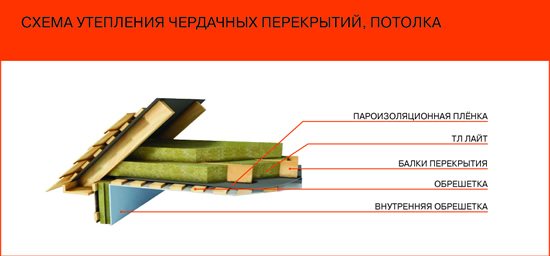

Ceiling insulation scheme from the attic.
The basic principles for installing the material from below are:
- Fixing fabrication and installation. Made from individual elements or a binder. To avoid unnecessary fastenings, the ceiling is sheathed gradually, immediately filling the void with material.
- The method is acceptable if there is enough space to accommodate the insulation. If the room is small, the way out is to build up the beam.
- With bad beams, a lathing for ceilings is used. Then the material is placed between the profile and covered with drywall.
If none of the above options is acceptable, it will be necessary to use foam or foam. In this case, the fasteners are made using tile glue or special foam glue. To carry out these works, the ceiling is primed.
The material is carefully coated with glue and pressed against the ceiling surface.
If necessary, the fasteners are reinforced with additional - fungi. "Fungi" fix the leaf in five places and vary in length. Therefore, when choosing this item, add at least 70 mm to the thickness of the insulation for fixing to the ceiling.
How to insulate the ceiling in a private house with mineral wool
Before installing the insulation, they first decide how to fix the mineral wool on the ceiling - outside (from the attic), inside (in the room), or both (combined method). External thermal insulation of the ceiling of a cottage or a private house is considered a more convenient, simple and economical installation method with such a building material, but the second method is not always used.
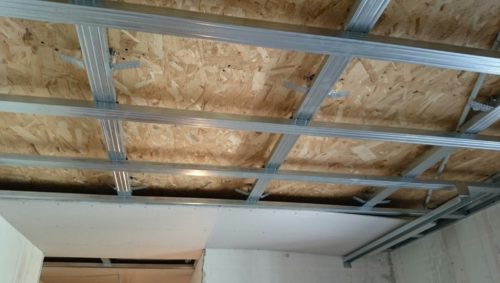

Since a false ceiling is installed in the room with internal insulation of the ceiling with fire-resistant mineral wool, the second method is not suitable for low private houses. Only if the height of the room is more than 2.5 m, then ceiling insulation with this building material is considered justified.
When using a combined installation, mineral wool is laid both from the attic and from the room side. More often, such installation work is carried out in a sauna, bathhouse and other places where it is necessary to ensure a high constant temperature for a long time.
Preparation for the installation of mineral wool on the ceiling
In order to properly insulate the ceiling with mineral wool, in preparation for installation, perform the following actions:
- calculate the amount of insulation (how many building materials are needed to install ceiling steam and waterproofing);
- prepare tools - a stapler, tape measure, knife, adhesive tape, several wooden slats, metal guide profiles and fasteners;
- prepare personal protective equipment - glasses, clothing, respirator and gloves.
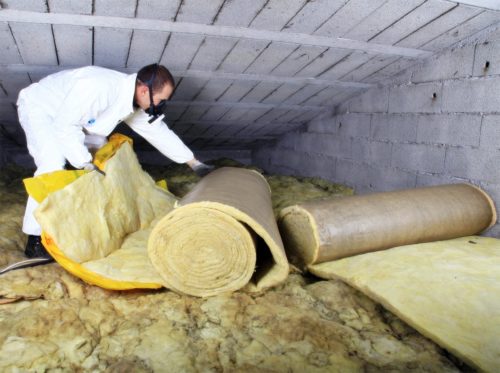

The insulation is unpacked only before installation. After the completion of the work, the room is cleaned with a vacuum cleaner, and then they take a warm shower.
Thickness of mineral wool for ceiling insulation
When choosing the thickness of the fire-resistant mineral wool, the climate in which the private house is located is taken into account. The quality of the installation work is directly related to the thickness of such a heater and the value of the thermal conductivity coefficient. Mineral wool mats, which have a low density, have less insulation thickness than tiles.
The thickness of mineral wool mats for thermal insulation of private households in northern latitudes is 206 mm, and in the middle lane - 163 mm. As a result, dense mineral wool has good thermal conductivity and is a fire-resistant building material.
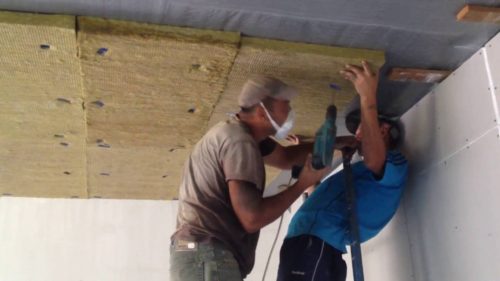

The outer walls of private households or cottages in the middle lane are covered with a layer of mineral insulation wool, the thickness of which is 120-140 mm. Moreover, the standard thickness of the insulation is a multiple of 50 mm. Mineral wool 80 mm thick cover the ceilings in IZHS houses.
How to attach insulation to the ceiling
When insulating a ceiling covering with mineral wool in a cottage or in a private house, the following tips from professionals are followed:
- the crate of several metal guide profiles is fixed with steel self-tapping screws, they firmly fix the mineral wool on the ceiling;
- during installation, mineral heat-insulating wool is not specially tamped and compressed with a press, such actions significantly reduce the thermal insulation of the building material;
- if the ceiling lathing is thinner than mineral wool, then in this case several wooden beams are stuffed onto the main boards.
Mineral wool
Mineral wool is a fiber made from textiles.
It can be purchased in rolls or blocks. The one that is made in the form of a track has more thermal insulation. It has not only better performance properties, but it is also much easier to work with.
How to fix insulation to the ceiling with mineral wool? Let's take a look at this issue.
Thanks to cotton wool, it becomes possible not only to insulate, but also to protect the room from excessive noise, since it has excellent sound insulation properties. The installation itself is carried out using dowels with a wide head. Self-tapping screws and self-adhesive tapes can serve as additional means for a more durable fastening.
Mineral wool on the ceiling
Installation instructions include the following stages of work:
Measurements are taken from the ceiling on which the installation is planned. Preparation of the slabs. They must correspond to the measurements taken and be completely identical. Holes for dowels are drilled in the ceiling. In this case, it is better to use plastic ones. With their help, metal profiles are installed on the base. Mineral insulation is applied to the profiles. After the application of mineral wool, the whole structure is fixed with dowels. Sheets are applied on top.
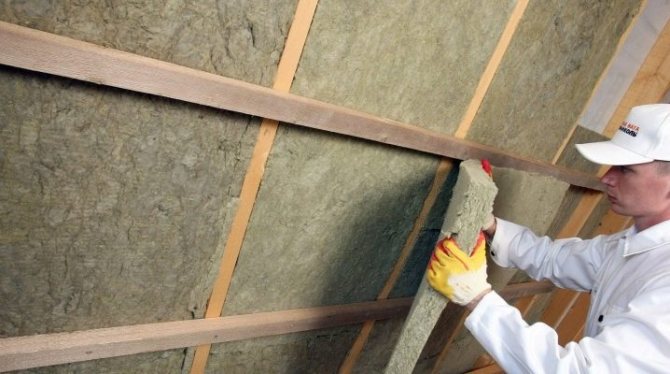

They also need to be secured as best as possible. This can be done with wooden slats and nails that resemble mushrooms in appearance. They got this name because of their wide head on top. During installation, there may be cracks and openings that it is advisable to fill with polyurethane foam.
Fastening mineral wool insulation has its advantages, such as:
- This material has high environmental parameters. It is hypoallergenic. It is durable in use due to the high quality of the means used. It does not undergo deformation. It is a fireproof material, which expands the range of its use. Application is possible even in the premises of a bath or sauna. A high percentage of vapor permeability.
One of the important aspects in the installation is that during installation, the material itself must be placed tightly, but in no case undergo deformation. Otherwise, it may lose its performance properties.
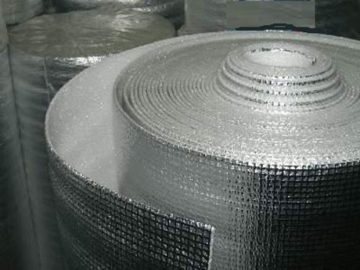

For a longer period of operation, it is advisable to cover the surface with an antifungal agent at the end of the installation work. This will allow further dust collection.
The choice of mineral wool by technical indicators
Insulating the ceiling in a private house with mineral wool means choosing the right material. The answer to the question of which mineral wool is better, experts consider on the basis of characteristics.
Insulation has two classifications:
- Mats - low strength indicators. Sold in rolls for easy transport.
- Plates - increased strength, two types - rigid and semi-rigid.
- Cylinders are a special material for pipeline insulation.
According to the raw materials used for the manufacture: basalt wool, glass, slag.
It is basalt fiber that has become widespread. Stone wool (the second name for basalt slabs) is highly durable and is used to insulate ceilings and walls subject to intense loads, incl. mechanical.
The material is produced from crushed and molten basalt, as a result of which the material has a fibrous structure. After that, the fibers are pressed and heated at high temperatures. Produces basalt wool, including in the form of slabs.
Advantages and choice of board thickness
Mineral wool has the following advantages:
- a light weight;
- elasticity;
- fire resistance;
- low price;
- long service life.
The thickness of the mineral wool is an important parameter when choosing a material. This indicator depends on the ceiling coverage. It also takes into account which method will be chosen to insulate the ceiling with mineral wool. So, with concrete floors, cotton wool is chosen with a thickness of at least 10 cm.In the presence of a heated attic, an insulation with a thickness of 8 cm is used.A pitched roof type involves the installation of a 30 cm thick mineral wool.
Some helpful tips
- It is preferable to insulate with mineral wool outside, since the use of this material can be harmful to health. If it is necessary to insulate the room from the inside, the layer of mineral wool must be carefully insulated.
- If the ceiling is strong enough, then expanded clay or sawdust can be poured under the layer of mineral wool.
- The crate for insulation should be made a little narrower than a sheet of mineral wool - the material will fit tightly into the cells.
- In the process of work, attention must be paid to isolating any crevices, especially in corners and places where the wall adjoins the ceiling.
If the attic space is heated and intended for living, then in this case the role of the "ceiling" is played by the roof slopes. They must be insulated in such a way that the dew point is between the roof covering and the vapor barrier. To do this, you need to make a gap between them, fixing the vapor barrier to the rafters.
As you can see, insulation of the ceiling with mineral wool, the price of which, despite the significant rise in the cost of building materials, remains quite low, a relatively simple task that can be done on your own.The cost of insulating ceilings with mineral wool depends on the price of the material, which varies depending on the type of mineral wool and the manufacturer's pricing policy, the area of ceiling ceilings and the cost of thermal insulation work, if performed by specialists.
Types of fasteners and technology for fastening mineral wool indoors
Insulation laying indoors, as a rule, is carried out in an apartment. Fastening of mineral wool is carried out in several stages:
- Erection of the frame. To do this, it is necessary to install a metal lathing for the false ceiling. The profile of the metal batten has standard parameters. For a wooden frame, boards of 30 × 100 mm or 40 × 200 mm are used, based on the weight of the boards. That is, the heavier they are, the more massive the crate will be. The slats must be fixed with dowels with suspensions, with a step of 55-60 cm. This distance is optimal when laying mineral wool in slabs.
- Installation of waterproofing material. The film is cut into strips of 65-70 cm, i.e. slightly larger than the width of the spacing between the slats. For fastening to a wooden frame, nails are used, for a metal one - self-tapping screws.
- The insulation is laid in two ways - using a construction stapler or on a specialized paste. Parallel to this, a vapor barrier is installed as a top layer.
The result of quality work is a consistently strong "cake" of three layers without gaps between the mineral slabs. Plasterboard is placed on the lower profile, which covers the thermal insulation. After that, you can install lighting devices and carry out decoration, according to the project.
